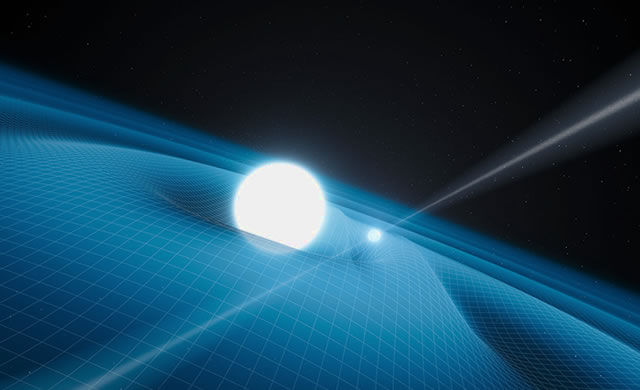
Una pulsar da record porta in nuovi territori le verifiche della relatività generale. – Alcuni astronomi hanno usato il VLT (Very Large Telescope) dell’ESO, insieme a radio telescopi di tutto il mondo, per trovare e studiare una bizzarra coppia di stelle formata dalla stella di neutroni più massiccia finora nota intorno a cui orbita una nana bianca. Questa strana binaria permette di verificare la teoria della gravità di Einstein – la relatività generale – in modi che finora non erano possibili. Per il momento, le nuove osservazioni sono perfettamente in accordo con le previsioni della relatività generale, mentre non sono consistenti con alcune delle teorie alternative. I risultati sarannno pubblicati dalla rivista Science il 26 aprile 2013.
Un’equipe internazionale ha scoperto un oggetto doppio un po’ strano, formato da un stella a neutroni, piccola ma insolitamente pesante, che ruota su se stessa 25 volte ogni secondo, intorno a cui ogni due ore e mezza orbita una nana bianca. La stella di neutroni è una pulsar che emette onde radio che possono essere intercettate dai radiotelescopi sulla Terra. È una coppia molto interessante di per sè, ma è anche un laboratorio unico di verifica dei limiti delle teorie fisiche. La pulsar si chiama PSR J0348+0432 ed è il resto di un’esplosione di supernova. È due volte più pesante del Sole, ma è grande solo 20 chilometri. La forza di gravità alla superficie è più di 300 miliardi di volte maggiore di quella sulla Terra e nel centro ogni cubetto di materia delle dimensioni di una zolletta di zucchero contiene più di un miliardo di tonnellate di materia. La compagna nana bianca è solo leggermente meno esotica: è il resto incandescente di una stella più leggera che ha perso la propria atmosfera e si sta ora lentamente raffreddando. “Stavo osservando il sistema con il VLT (Very Large Telescope) dell’ESO, alla ricerca di cambiamenti nella luce emessa dalla bana bianca, a causa del suo moto intorno alla pulsar”, dice John Antoniadis, uno studente di dottorato all’Istituto del Max Planck per la Radioastronomia (MPIfR) a Bonn e primo autore dell’articolo. “Un’analisi veloce, a caldo, mi ha fatto capire che la pulsar è un vero peso massimo: è circa due volte la massa del Sole, il che la rende la stella a neutroni più massiccia che si conosca e anche un laboratorio eccellente per la fisica fondamentale”. La teoria della relatività generale di Einstein, che spiega la forza di gravità come una conseguenza della curvatura dello spazio-tempo dovuta alla presenza di massa ed energia, ha superato tutti i controlli fin dall’epoca della sua pubblicazione, un centinaio di anni fa. Ma non può essere la spiegazione finale e alla fine dovrà essere modificata.
Fonte/Leggi tutto → ESO.org
Record-breaking pulsar takes tests of general relativity into new territory – Astronomers have used ESO’s Very Large Telescope, along with radio telescopes around the world, to find and study a bizarre stellar pair consisting of the most massive neutron star confirmed so far, orbited by a white dwarf star. This strange new binary allows tests of Einstein’s theory of gravity — general relativity — in ways that were not possible up to now. So far the new observations exactly agree with the predictions from general relativity and are inconsistent with some alternative theories. The results will appear in the journal Science on 26 April 2013.
An international team has discovered an exotic double object that consists of a tiny, but unusually heavy neutron star that spins 25 times each second, orbited every two and a half hours by a white dwarf star. The neutron star is a pulsar that is giving off radio waves that can be picked up on Earth by radio telescopes. Although this unusual pair is very interesting in its own right it is also a unique laboratory for testing the limits of physical theories. This pulsar is named PSR J0348+0432 and is the remains of a supernova explosion. It is twice as heavy as the Sun, but just 20 kilometres across. The gravity at its surface is more than 300 billion times stronger than that on Earth and at its centre every sugar-cubed-sized volume has more than one billion tonnes of matter squeezed into it. Its companion white dwarf star is only slightly less exotic; it is the glowing remains of a much lighter star that has lost its atmosphere and is slowly cooling. “I was observing the system with ESO’s Very Large Telescope, looking for changes in the light emitted from the white dwarf caused by its motion around the pulsar,” says John Antoniadis, a PhD student at the Max Planck Institute for Radio Astronomy (MPIfR) in Bonn and lead author of the paper. “A quick on-the-spot analysis made me realise that the pulsar was quite a heavyweight. It is twice the mass of the Sun, making it the most massive neutron star that we know of and also an excellent laboratory for fundamental physics.” Einstein’s general theory of relativity, which explains gravity as a consequence of the curvature of spacetime created by the presence of mass and energy, has withstood all tests since it was first published almost a century ago. But it cannot be the final explanation and must ultimately break down.
Source/Continue reading → ESO.org

















